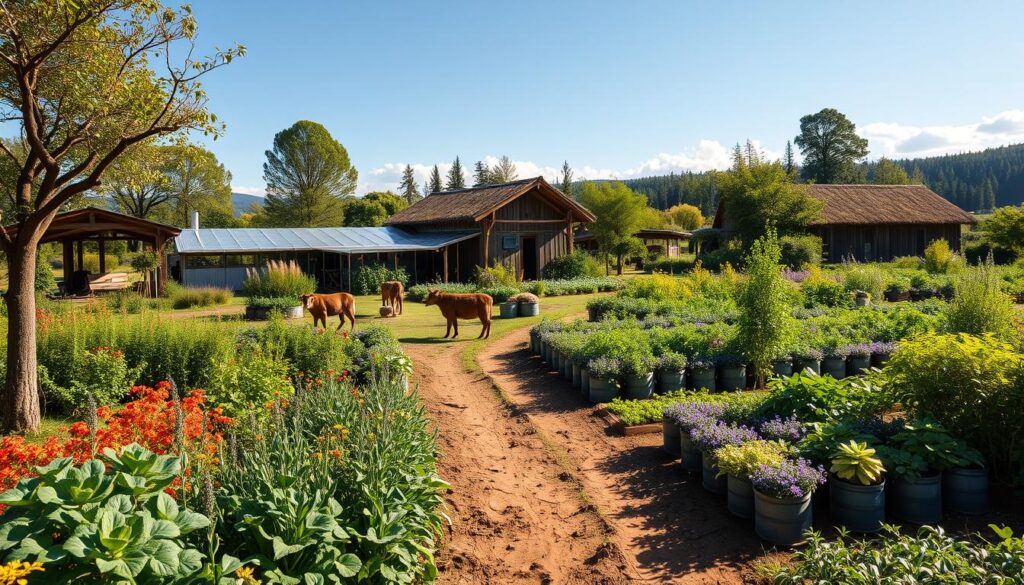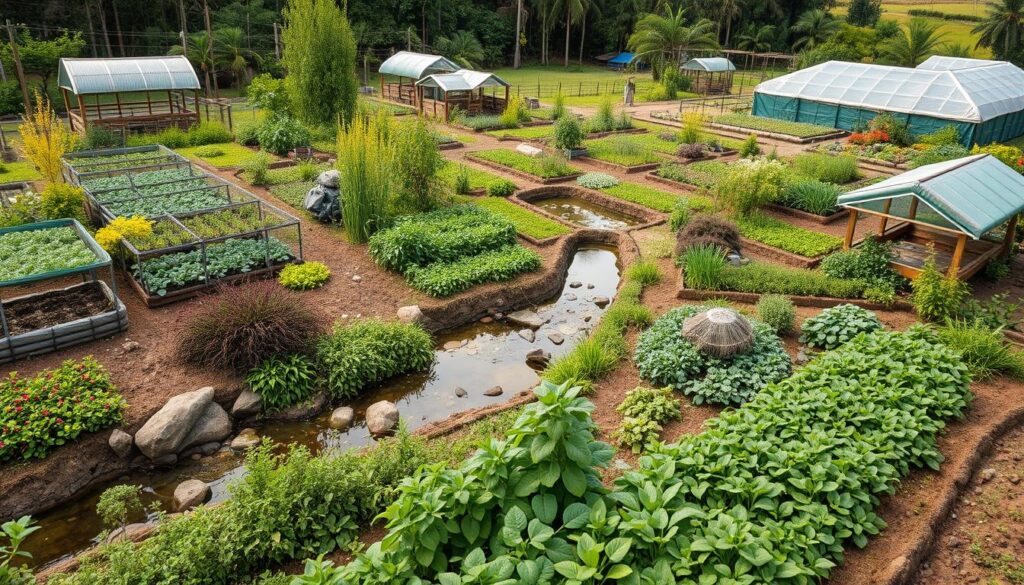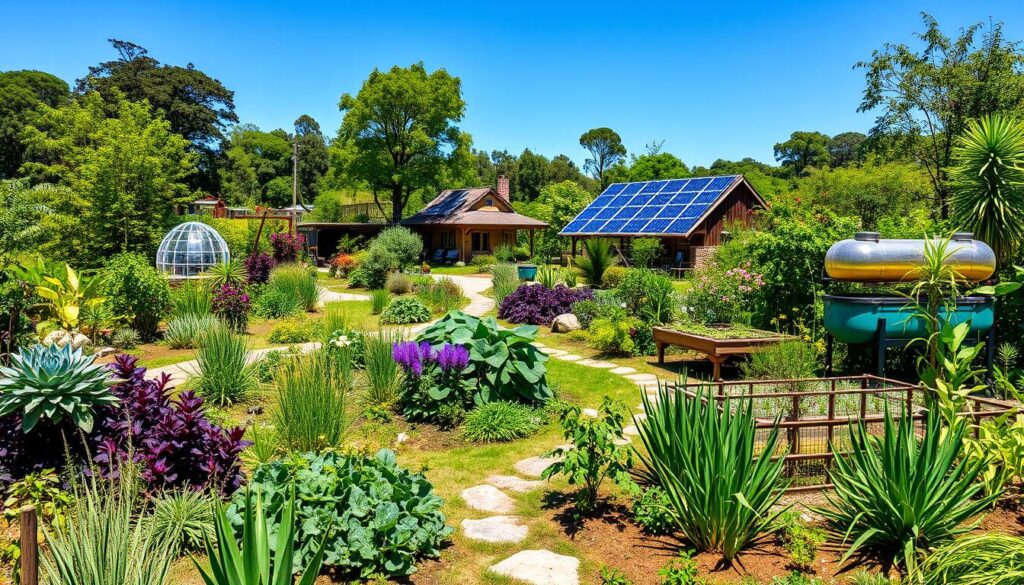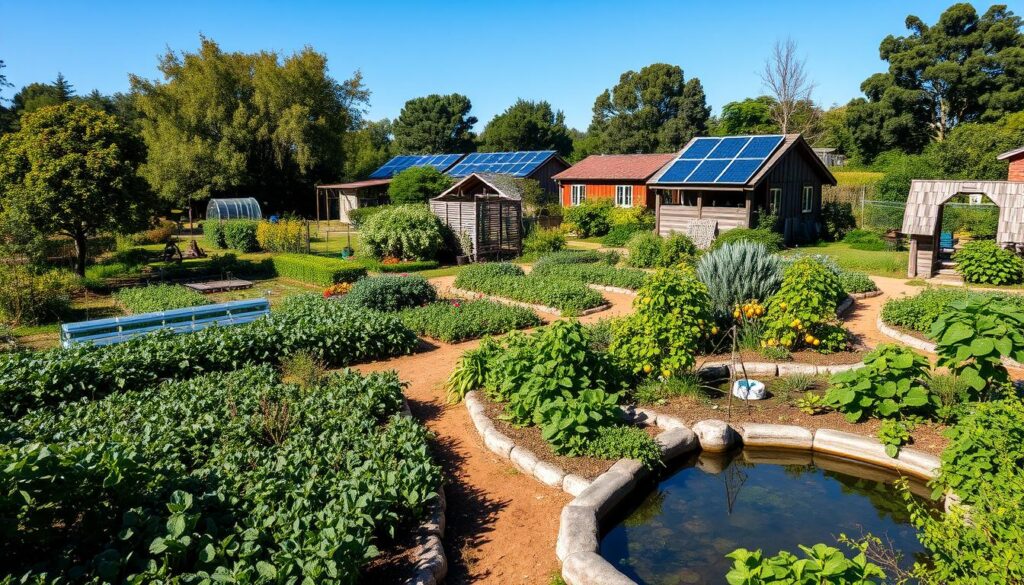Imagine businesses that grow while helping the planet and people. This is what permaculture business models offer. They use regenerative design to make companies more sustainable. As we move towards greener ways, these models are key for businesses wanting to lessen their impact.
By using permaculture, companies can help create a better future. To learn more, check out permaculture design certification at https://www.ecoversity.org/online-live-permaculture-design-certification.
Permaculture business models focus on green farming and design. They aim to make a positive difference for the planet and people. With more people seeing the value of nature, these models are set to be big in the future of green business.
Working together and being creative are crucial for success. As 44% of nature-based solutions involve both governments and groups, teamwork is essential.
Key Takeaways
- Permaculture business models apply regenerative design principles to create sustainable enterprises.
- Sustainable agriculture and environmental sustainability are core components of permaculture business models.
- Collaboration and innovative approaches are essential for successful permaculture business models.
- Nature-based solutions, including permaculture business models, offer cost-effective and beneficial approaches to sustainability.
- Permaculture business models can contribute to local socio-economic and environmental sustainability, adhering to ecotourism principles.
- Businesses can reduce their environmental footprint by incorporating permaculture principles into their operations.
- Permaculture design certification courses can provide valuable knowledge and skills for implementing permaculture business models.
Understanding Permaculture Business Models
Permaculture is a way to design systems that are good for the environment, society, and the economy. It’s key for businesses that want to be ethical and care for the planet. By using permaculture, businesses can make a positive difference and still make money.
The main ideas of permaculture include making systems that work on their own, are diverse, and can bounce back. These ideas can help businesses in many ways, like how they manage supplies and serve customers. Taking a holistic view of business can help companies be better for the environment, society, and their bottom line.
Some good things about permaculture business models are:
- They help businesses be more sustainable and profitable
- They promote caring for the environment
- They make customers happier and more loyal
- They help reduce waste and work more efficiently
Companies like Patagonia show that it’s possible to make money and care for the planet at the same time. By looking at business in a whole new way, companies can make a positive impact and still earn profits over time.
| Principle | Description |
|---|---|
| Earth Care | Designing systems that are environmentally sustainable |
| People Care | Designing systems that are socially responsible |
| Fair Share | Designing systems that are economically viable |
Types of Permaculture Business Models
Permaculture business models focus on being green and responsible while making money and creating jobs. They can take many forms, like market gardens, education, eco-tourism, and CSAs. By using organic farming and green business practices, these businesses can lessen their environmental footprint and support social responsibility.
Some permaculture businesses show that organic farming can be both profitable and good for the planet. For instance, La Ferme du Bec Hellouin in France gets ten times more yield than big farms, even though it’s small. This approach has inspired 80% of French organic gardeners.

Market Garden Operations
Market gardens grow and sell different crops, often using organic farming methods. This model can be both profitable and sustainable, as seen with La Ferme du Bec Hellouin.
Education and Workshop Programs
Education and workshop programs teach people about permaculture and green business practices. They help spread social responsibility and environmental care.
Designing Your Permaculture Business
When starting a permaculture business, it’s key to think about the whole ecosystem. Look at the site, pick the right crops, and add wildlife and biodiversity. This way, entrepreneurs can build businesses that care for the environment and society.
A regenerative design means making a system that works on its own, wasting less and doing more. Use composting, collect rainwater, and choose green energy. This way, permaculture businesses can lessen their harm to the planet and help it last longer.
Some important things to think about when designing a permaculture business include:
* Do a detailed site check to figure out the best land use
* Pick crops that fit the local weather and soil
* Add wildlife and biodiversity to keep the ecosystem healthy
* Make water use efficient to save resources
* Choose green energy to cut down on fossil fuels
| Design Principle | Description |
|---|---|
| Obtain a yield | Make sure the business is making something, like a product or service |
| Catch and store energy | Use methods like rainwater harvesting and composting to save energy |
| Obtain a yield, catch and store energy, and apply self-regulation and accept feedback | Keep an eye on how the business is doing and tweak it as needed for sustainability |
By sticking to these design rules and taking a big-picture view, permaculture businesses can help the planet, people, and make money too.
Financial Considerations for Permaculture Ventures
Starting a permaculture business means looking at the money side of things. You need to know about start-up costs, where to get funding, how to price things, and making money in different ways. This way, your business can last a long time and help the planet and people.
Understanding the costs of starting and running a permaculture business is key. This includes buying land, setting up, and getting the right tools. It also means paying for seeds, fertilizers, and workers. The Financial Permaculture Institute says making local businesses better is important for lasting success. To learn more, check out financial permaculture resources.
To stay financially strong, permaculture businesses can sell products, offer classes, and work with other local businesses. By being socially responsible and caring for the environment, they can attract customers who value these things. Here are some important money matters for permaculture businesses:
| Financial Consideration | Description |
|---|---|
| Start-up Costs | Initial investments in land, infrastructure, and equipment |
| Funding Sources | Grants, loans, and crowdfunding options for permaculture businesses |
| Pricing Strategies | Setting prices for permaculture products and services to ensure financial sustainability |
Marketing Strategies for Permaculture Businesses
Marketing is key for permaculture businesses to succeed. It helps them find and share their message with the right people. A good marketing plan builds a strong brand and loyal customers. It also shows the business’s values, attracting like-minded people.
Some important marketing strategies include:
- Defining a Unique Selling Proposition (USP) to stand out
- Identifying an Ideal Customer Avatar for better targeting
- Understanding the market to improve what you offer and how much you charge
By planning well, permaculture businesses can save up to 40% of their marketing budget. A solid marketing plan can bring great returns, making the most of money and time spent on ads.

Joe Görbert, a business consultant, says making financial plans is crucial. He advises starting slow with marketing, focusing on solid planning first. This way, businesses can use their resources wisely and succeed.
| Marketing Strategy | Benefits |
|---|---|
| Defining a USP | Differentiation in a crowded market |
| Identifying an Ideal Customer Avatar | Targeted marketing efforts |
| Understanding the business ecosystem | Optimized offerings and pricing strategies |
Legal and Regulatory Aspects
Knowing the legal and regulatory sides of permaculture businesses is key to their success. This means taking care of the environment and reducing the business’s impact. Claudio Vitari and Christophe David, in “Sustainable management models: innovating through Permaculture,” stress the importance of social responsibility and following laws.
To stay in line, permaculture businesses need the right permits and licenses. This includes zoning, health department, and environmental permits. By focusing on green business practices, they can lessen their environmental footprint and look towards a sustainable future.
- Understanding zoning laws and regulations
- Obtaining necessary permits and licenses
- Implementing environmental compliance practices
By sticking to these rules and valuing environmental stewardship, social responsibility, and green practices, permaculture businesses can meet legal standards. This way, they can thrive in the long run.
| Permaculture Business | Environmental Impact | Social Responsibility |
|---|---|---|
| Market garden operations | Minimized water usage | Community involvement |
| Eco-tourism ventures | Promoting sustainable tourism | Supporting local communities |
| Community supported agriculture (CSA) | Reduced carbon footprint | Encouraging social interaction |
Integrating Technology in Permaculture
Permaculture businesses are using technology to improve their work. They mix regenerative design with modern tools. This helps them work better, use less resources, and support sustainable agriculture.
Jason Thomas says technology is key for permaculture businesses. It helps them grow from students to professionals. By using technology wisely, they can build businesses that care for the environment and people.
Tools for Precision Farming
Tools for precision farming are vital in permaculture. They make farming more accurate and efficient. These tools help save resources and support sustainable farming.
Software for Business Management
Software for managing businesses is also important. It helps permaculture businesses run smoothly and make smart choices. This software lets them use a holistic approach in their work.
Using Drones for Monitoring Crops
Drones help monitor crops in permaculture. They spot problems early and cut down on harmful chemicals. This supports sustainable farming and caring for the environment.

By using technology and a holistic approach, businesses can be more sustainable. They focus on caring for the environment and people. This helps create a better future for farming.
| Technology | Benefits |
|---|---|
| Precision Farming Tools | Increased efficiency, reduced waste |
| Business Management Software | Streamlined operations, effective financial management |
| Drones for Crop Monitoring | Early issue detection, reduced chemical use |
Building a Sustainable Supply Chain
Businesses are now focusing on green business practices. They aim to be socially responsible and protect the environment in their supply chains. This means finding seeds and inputs ethically, working with local farms, and using permaculture in their management.
A green supply chain helps cut down on carbon emissions and supports eco-friendly actions. Studies show that companies following environmental stewardship can cut their carbon footprint by up to 40%. Also, social responsibility efforts can make supplier relationships better and boost customer loyalty.
Here are some ways to build a sustainable supply chain:
- Use regenerative agriculture to lower chemical use
- Partner with local farms to cut down on emissions
- Use data to make better logistics choices and save resources
By choosing green business practices and focusing on social responsibility and environmental stewardship, companies can make a positive difference. They help the environment and support sustainable growth.
| Strategy | Impact |
|---|---|
| Regenerative agriculture practices | Reduce chemical pesticide and fertilizer use by up to 50% |
| Partnerships with local farms | Reduce transportation emissions by up to 20% |
| Data-driven decision-making tools | Optimize logistics and reduce resource usage by up to 30% |
Case Studies of Successful Permaculture Businesses
Successful permaculture businesses use a model that focuses on sustainable agriculture and design. This approach helps the environment and makes the business financially stable.
A market garden started with $2,000 and made $2,000 in sales by the end of its first year. This shows how a good permaculture business plan can lead to quick success.
Notable Examples in the U.S.
In the U.S., many permaculture projects have done well. For example, the UMass Permaculture Initiative started in 2010. It has created many permaculture gardens, showing how permaculture can help with food and education.

Lessons Learned from Market Leaders
Market leaders in permaculture succeed because they understand regenerative design well. They also know how to apply it to their business needs. Important lessons include doing thorough site assessments, diversifying income, and connecting with local communities.
By using a permaculture business model, entrepreneurs can build successful and sustainable businesses. These businesses help the environment and improve community well-being.
Challenges Facing Permaculture Businesses
Permaculture businesses face many challenges, like climate change and market competition. By using a holistic approach to manage their businesses, permaculture entrepreneurs can overcome these hurdles. This helps in building a more sustainable future.
One big challenge is balancing ethical entrepreneurship with making money. It’s important to understand the market well and create a business model that works. Some of the main challenges include:
- Climate change and environmental issues
- Market competition from industrial agriculture
- Lack of access to financing and resources
Despite these obstacles, permaculture businesses can have a big positive impact. By focusing on environmental stewardship and social responsibility, they can help create a better food system. This promotes ethical entrepreneurship practices.
| Challenge | Solution |
|---|---|
| Climate change | Implement sustainable practices, such as renewable energy and carbon sequestration |
| Market competition | Develop a unique value proposition and build strong relationships with customers |
| Lack of access to financing | Explore alternative funding options, such as crowdfunding and community-supported agriculture programs |
By tackling these challenges and using a holistic approach to business management, permaculture entrepreneurs can build a more sustainable food system.
Community Engagement and Permaculture
Permaculture businesses can make a big difference in their local communities. They focus on social responsibility and caring for the environment. This is done through community engagement, which is key for their success.
Jason Thomas, author of “Permaculture Entrepreneurship,” says community engagement is vital. It helps permaculture businesses grow and thrive.
By using green business practices and sustainable agriculture, these businesses help their communities. They can do this in several ways:
- Creating educational opportunities, such as workshops and training programs
- Developing partnerships with local organizations and businesses
- Implementing community-based projects, such as community gardens and green spaces
Engaging with their communities helps permaculture businesses build trust. It also encourages collaboration and promotes sustainable agriculture. This leads to a stronger, more sustainable local food system. It’s good for people and the planet.
Future Trends in Permaculture Business
As the world moves towards sustainability, permaculture businesses lead the way. They use a holistic approach to create regenerative design systems. These systems help the environment and support social causes.
By using permaculture in business, companies can use less resources and waste less. This makes them appealing to people who care about the planet.
Urban permaculture is growing fast. It meets the demand for green products and services. It also helps cities grow food locally and care for the environment.
Urban permaculture brings people together and teaches them about sustainability. This makes a big difference in communities.
Permaculture businesses have a big impact globally. They can cut resource use by 25% and help the planet. By using permaculture business models and regenerative design, companies can save money and help the environment.
Studies show that sustainable practices can save companies $2 to $7 for every dollar spent. This is good for both the planet and the company’s wallet.
| Benefits of Permaculture Business Models | Environmental Impact | Social Responsibility | Economic Benefits |
|---|---|---|---|
| Reduced Resource Utilization | 25% reduction in waste | Community engagement and education | Potential cost savings of $2 to $7 per dollar spent |
| Increased Sustainability | Improved environmental stewardship | Job creation and local economic growth | Enhanced brand reputation and customer loyalty |
Personal Development and Skill Building
For permaculture entrepreneurs, personal growth and skill development are key. They help in creating effective business strategies and ensure long-term success. It’s important to learn about sustainable agriculture and green business practices to make smart choices and grow.
Jason Thomas, author of “Permaculture Entrepreneurship: Navigating the Path from Student to Professional,” stresses the importance of personal growth. By focusing on social responsibility and sustainable agriculture, entrepreneurs can positively impact their communities and the environment.
Some essential skills for permaculture entrepreneurs include:
- Understanding of permaculture principles and their application in business
- Knowledge of sustainable agriculture and green business practices
- Ability to integrate social responsibility into business decisions
By focusing on personal development and skill building, permaculture entrepreneurs can lay a solid foundation for their businesses. This contributes to a more sustainable future.
| Skill | Importance |
|---|---|
| Knowledge of permaculture principles | High |
| Understanding of sustainable agriculture | High |
| Social responsibility integration | Medium |
Measuring Success in Permaculture Ventures
Success in permaculture ventures means looking at everything together. This includes environmental stewardship and helping people. Claudio Vitari and Christophe David say this is key for lasting positive change.
It’s also about being ethical in business. This means thinking about money, people, and the planet together. Permaculture businesses aim to make the world better for everyone.
Defining Key Performance Indicators (KPIs)
Permaculture ventures need to track more than just money. They should look at things like soil health, how many species they support, and water quality. These are important for success.
Assessing Environmental Impact
It’s important to check how permaculture ventures affect the environment. They should watch how their actions impact nature and change if needed. This helps protect the planet.
By focusing on the whole picture, permaculture ventures can be good for money, people, and the planet. This way, they help build a better future. It’s all about doing business the right way.
Conclusion: The Future of Permaculture Business Models
The permaculture movement has grown over 45 years. Its future in business looks bright. By using the
regenerative design
principles, entrepreneurs can start
holistic
and
sustainable
businesses. These businesses help the environment and local communities.
Permaculture is used in many ways, like community-supported agriculture and eco-tourism. It shows how versatile permaculture can be. Businesses that follow a
permaculture business model
make money and help the food system. They use closed-loop systems and renewable energy to reduce waste and emissions.
For those starting in permaculture, learning and community are key. Joining the permaculture community and getting education can open new doors. With a focus on sustainability and adapting to changes, the future is bright.
Starting your permaculture business? Follow the movement’s holistic principles. Regenerate the land, care for the community, and protect the environment. This way, you’ll build a successful and lasting business.

